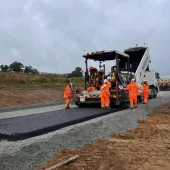Reducing Disruption When Resurfacing the A66

First published in the January 2017 issue of Quarry Management as Low-temperature Treatment
When Highways England was looking for a solution that could significantly reduce disruption during resurfacing work on the A66 in the North East, Tarmac and A-one+ worked in partnership to cut costs, carbon and project timescales
Reducing the cost and time it takes to maintain the strategic road network are key drivers in Highways England’s roads programme. New ways of working, which include innovative technologies and improved supply chain collaboration, need to come to the fore.
A combination of these was successfully used by Highways England, A-one+ (the Managing Agent Contractor for Area 14) and Tarmac when they undertook resurfacing work on the A66 from Surtees Bridge to the Teesside Park Interchange in Thornaby, Stockton-on-Tees.
Running across the river Tees, Surtees Bridge carries the A66 dual carriageway and links the A1(M) and Darlington with Middlesbrough. As one of the busiest bridges on the Tees, the resurfacing work could only be carried out at night from 8.00pm until 6.00am, when the carriageway had to reopen.
To overcome these challenges, the scheme partners worked in collaboration to develop a bespoke solution that would cut the timescale of the resurfacing, compared with similar historic projects of this size.
Early engagement
Early technical engagement allowed Tarmac’s team to provide input into the buildability of the project. The team was invited to contractor workshops organized by A-one+, as Ian Carr, technical manager at Tarmac, explained: ‘Through our discussions with Highways England and A-one+, we looked closely at how we could minimize disruption for road users and local people during the resurfacing work. Low-temperature asphalt technology has contributed to reducing resurfacing timescales and cutting carbon on many projects, and we felt that there was a real opportunity to use this material on the A66.’
Low-temperature asphalt technology consists of three types of material, classified by the temperature at which they are mixed and laid. These materials differ from hot asphalt, which is typically mixed at 140°C to 190°C, in that the manufacturing process – and in particular the characteristics of the binder – is modified during mixing. This allows for more efficient production, improves mixture workability and allows effective compaction at a lower temperature. This is achieved by modifying the behaviour of the bitumen through foaming or the use of additives during manufacturing.
Martin Bolt, NDD (Network Delivery and Development) operational support group leader with Highways England, commented: ‘We had a narrow time frame to complete our resurfacing works and the low-temperature asphalt could be laid more quickly because it takes less time to cool. This allowed us to complete our work earlier, which, in turn, reduced the disruption to road users, increased the productivity of the workforce and also improved road worker safety by reducing exposure to risk.’
Tarmac’s Ian Carr added: ‘Typically, hot asphalt surface course is mixed at very high temperatures between 170°C and 190°C. However, Tarmac Ultilow is mixed at around 40°C lower than its equivalent hot mix. The lower temperatures meant that work on the A66 was completed earlier, increasing the productivity of the workforce and allowing the road to be opened sooner, resulting in less public disruption.’
Over the course of one month, Tarmac planed and refurbished a total area of 19,745m2. As the total depth of construction was 160mm, two types of Ultilow EME2 binder were used in two 80mm layers. The team used 4,350 tonnes of Ultilow EME2 (limestone) binder and 4,185 tonnes of Ultilow EME2 (basalt) binder. The aggregate type was varied to achieve the project requirements for the trafficked binder. These binder courses acted as a support layer prior to the finished surface course, which consisted of a 10mm layer of stone-mastic asphalt (SMA).
Cutting carbon and costs
A comparison with similar-sized road schemes using hot-rolled asphalt has indicated that the use of low-temperature asphalt on the A66 helped to reduce the project by 14 shifts, equating to savings of £67,000 by cutting labour and plant costs.
Moreover, the reduced temperature of the materials also meant that considerable carbon savings were achieved. This was made possible by the reduced embodied carbon of low-temperature asphalt compared with conventional hot mixes – the use of low-temperature asphalt can deliver carbon savings of up to 25%.
On the A66 project, the use of low-temperature asphalt instead of traditional materials resulted in a carbon saving of around 14 tonnes (14.2 tCO2e). Ian Carr concluded: ‘The Government’s 2025 Construction Strategy holds carbon reduction at its heart and our work on the A66 shows that it’s possible to embed this approach in road refurbishment projects.’
- Subscribe to Quarry Management, the monthly journal for the mineral products industry, to read articles before they appear on Agg-Net.com








